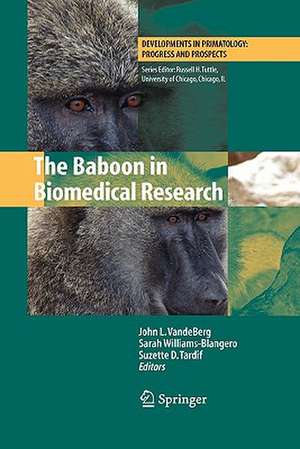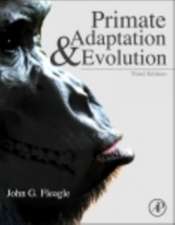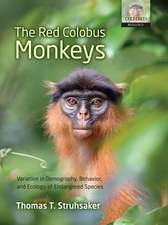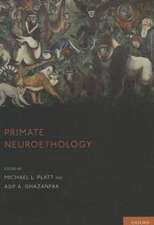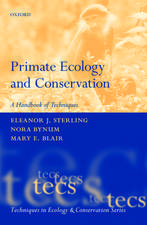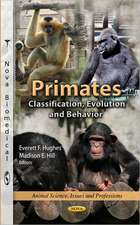The Baboon in Biomedical Research: Developments in Primatology: Progress and Prospects
Editat de John L. VandeBerg, Sarah Williams-Blangero, Suzette D. Tardifen Limba Engleză Paperback – 6 dec 2010
| Toate formatele și edițiile | Preț | Express |
|---|---|---|
| Paperback (1) | 950.21 lei 6-8 săpt. | |
| Springer – 6 dec 2010 | 950.21 lei 6-8 săpt. | |
| Hardback (1) | 954.45 lei 6-8 săpt. | |
| Springer – 21 noi 2008 | 954.45 lei 6-8 săpt. |
Din seria Developments in Primatology: Progress and Prospects
- 20%
 Preț: 571.31 lei
Preț: 571.31 lei - 18%
 Preț: 1216.65 lei
Preț: 1216.65 lei - 19%
 Preț: 578.66 lei
Preț: 578.66 lei - 18%
 Preț: 956.69 lei
Preț: 956.69 lei - 18%
 Preț: 948.92 lei
Preț: 948.92 lei - 18%
 Preț: 948.92 lei
Preț: 948.92 lei - 18%
 Preț: 945.79 lei
Preț: 945.79 lei - 18%
 Preț: 962.66 lei
Preț: 962.66 lei - 18%
 Preț: 1664.43 lei
Preț: 1664.43 lei - 18%
 Preț: 1224.54 lei
Preț: 1224.54 lei - 24%
 Preț: 826.25 lei
Preț: 826.25 lei - 24%
 Preț: 802.74 lei
Preț: 802.74 lei - 18%
 Preț: 1562.94 lei
Preț: 1562.94 lei - 18%
 Preț: 943.73 lei
Preț: 943.73 lei - 18%
 Preț: 1549.67 lei
Preț: 1549.67 lei - 18%
 Preț: 1248.20 lei
Preț: 1248.20 lei - 18%
 Preț: 941.38 lei
Preț: 941.38 lei - 24%
 Preț: 800.85 lei
Preț: 800.85 lei - 18%
 Preț: 953.35 lei
Preț: 953.35 lei - 18%
 Preț: 1827.48 lei
Preț: 1827.48 lei - 18%
 Preț: 1209.52 lei
Preț: 1209.52 lei - 18%
 Preț: 957.62 lei
Preț: 957.62 lei - 18%
 Preț: 1231.47 lei
Preț: 1231.47 lei - 18%
 Preț: 1225.48 lei
Preț: 1225.48 lei - 5%
 Preț: 1433.83 lei
Preț: 1433.83 lei - 18%
 Preț: 1231.16 lei
Preț: 1231.16 lei - 18%
 Preț: 1226.90 lei
Preț: 1226.90 lei - 18%
 Preț: 955.25 lei
Preț: 955.25 lei - 18%
 Preț: 956.03 lei
Preț: 956.03 lei - 18%
 Preț: 1218.53 lei
Preț: 1218.53 lei - 18%
 Preț: 950.52 lei
Preț: 950.52 lei -
 Preț: 416.82 lei
Preț: 416.82 lei - 18%
 Preț: 1554.89 lei
Preț: 1554.89 lei
Preț: 950.21 lei
Preț vechi: 1158.79 lei
-18% Nou
Puncte Express: 1425
Preț estimativ în valută:
181.81€ • 190.85$ • 150.92£
181.81€ • 190.85$ • 150.92£
Carte tipărită la comandă
Livrare economică 10-24 aprilie
Preluare comenzi: 021 569.72.76
Specificații
ISBN-13: 9781441926159
ISBN-10: 1441926151
Pagini: 416
Ilustrații: XXIV, 392 p.
Dimensiuni: 155 x 235 x 22 mm
Greutate: 0.58 kg
Ediția:Softcover reprint of hardcover 1st ed. 2009
Editura: Springer
Colecția Springer
Seria Developments in Primatology: Progress and Prospects
Locul publicării:New York, NY, United States
ISBN-10: 1441926151
Pagini: 416
Ilustrații: XXIV, 392 p.
Dimensiuni: 155 x 235 x 22 mm
Greutate: 0.58 kg
Ediția:Softcover reprint of hardcover 1st ed. 2009
Editura: Springer
Colecția Springer
Seria Developments in Primatology: Progress and Prospects
Locul publicării:New York, NY, United States
Public țintă
ResearchCuprins
The Development and Status of the Baboon Genetic Linkage Map.- The Study of Captive Baboon Behavior.- Spontaneous Pathology of Baboons.- Growth and Development of Baboons.- Reproductive Biology of Baboons.- Microbiology of Captive Baboons.- Baboon Model for Endometriosis.- The Baboon in Embryology and Teratology Research.- Baboon Models for Neonatal Lung Disease.- The Baboon Model for Dental Development.- Baboon Model for Dyslipidemia and Atherosclerosis.- Baboon Model for the Study of Nutritional Influences on Pregnancy.- Baboon Model for Infant Nutrition.- Baboon Model for Ingestive Behaviors.- Baboon Model for Alcoholic Liver Disease: 1973–2003.- Baboons in Drug Abuse Research.- Neuroimaging in Baboons.- The Baboon Model of Epilepsy: Current Applications in Biomedical Research.- The Baboon in Xenotransplant Research.
Textul de pe ultima copertă
Building on the foundation of two earlier volumes, The Baboon in Biomedical Research returns in an updated edition that presents the variety of uses and the importance of the baboon in biomedical research today. With contributions from leading researchers who use the baboon model, the new edition, edited by John L. VandeBerg, Suzette D. Tardif, and Sarah Williams-Blangero, provides a cogent introduction to this nonhuman primate model and serves as a valuable guide for researchers as well as laboratory animal veterinarians.
The volume begins with a chapter on the baboon gene map, the first genetic linkage map developed for any nonhuman primate species. Subsequent chapters present the results of decades of research on basic biological characteristics of baboons: microbiology, reproductive biology, growth and development, behavior, and spontaneous pathology. The remaining chapters summarize the scientific contributions of baboons as models of human diseases or physiological or developmental characteristics, including neonatal lung disease, dental development, dyslipidemia and atherosclerosis, pregnancy, ingestive behaviors, infant nutrition, alcoholic liver disease, drug abuse, neuroimaging, epilepsy, and xenotransplantation. The baboon already has a 50-year history of significant contributions as a model for human states of health and disease. This volume highlights the exciting research that is currently being conducted with this animal model and suggests future directions for the baboon in biomedical research.
The volume begins with a chapter on the baboon gene map, the first genetic linkage map developed for any nonhuman primate species. Subsequent chapters present the results of decades of research on basic biological characteristics of baboons: microbiology, reproductive biology, growth and development, behavior, and spontaneous pathology. The remaining chapters summarize the scientific contributions of baboons as models of human diseases or physiological or developmental characteristics, including neonatal lung disease, dental development, dyslipidemia and atherosclerosis, pregnancy, ingestive behaviors, infant nutrition, alcoholic liver disease, drug abuse, neuroimaging, epilepsy, and xenotransplantation. The baboon already has a 50-year history of significant contributions as a model for human states of health and disease. This volume highlights the exciting research that is currently being conducted with this animal model and suggests future directions for the baboon in biomedical research.
Caracteristici
First volume since 1965 to provide in depth study of Baboon in Biomedical Research Among all primates, baboons are the most widely used as models for the genetics of susceptibility to complex diseases and they are the first nonhuman primate for which a framework genetic linkage map was established In addition, the baboon genome is currently being sequenced, and as a result the utility of this species for biomedical research will be dramatically increased
